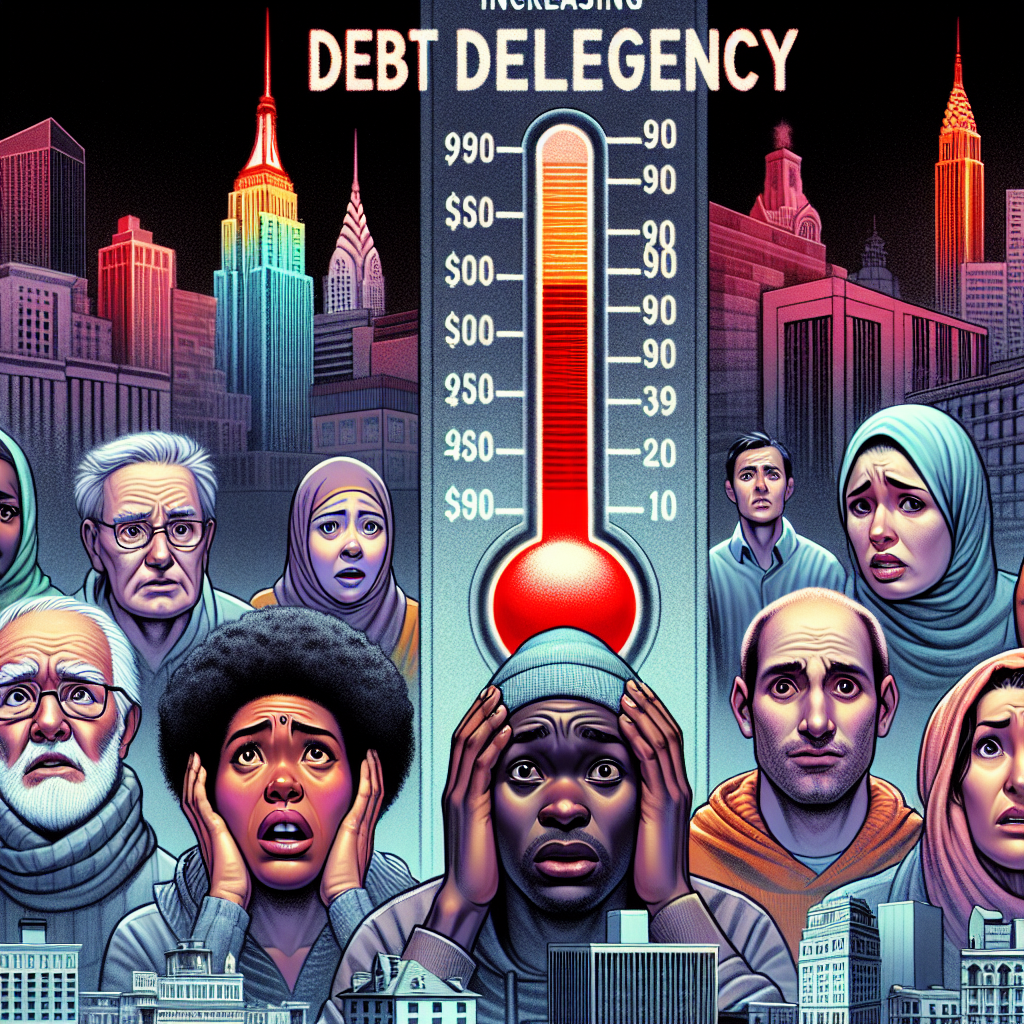“Rising Red Flags: New York Fed Highlights Growing Debt Delinquency in America”
Introduction
In recent analyses, the New York Federal Reserve has highlighted a concerning trend of rising debt delinquency among American consumers. This development underscores growing financial pressures faced by households across the nation, as economic uncertainties and inflationary pressures continue to impact personal finances. The report indicates an uptick in missed payments and defaults across various types of consumer debt, including credit cards, auto loans, and mortgages. This increase in delinquency rates raises alarms about the potential for broader economic repercussions, as individuals struggle to manage their financial obligations amidst a challenging economic landscape. The findings call for close monitoring and potential policy interventions to address the underlying causes and mitigate the risks associated with escalating consumer debt burdens.
Understanding the Rise in Debt Delinquency: Insights from the New York Fed Report
The recent report from the New York Federal Reserve has shed light on a concerning trend: an increase in debt delinquency among Americans. This development is significant as it reflects broader economic challenges and has implications for both individual financial health and the overall economy. Understanding the factors contributing to this rise in delinquency is crucial for policymakers, financial institutions, and consumers alike.
To begin with, the report highlights that the delinquency rates have been climbing steadily over the past few quarters. This uptick is particularly evident in credit card and auto loan delinquencies, which have seen notable increases. Several factors are driving this trend, with inflation being a primary concern. As the cost of living rises, many Americans find it increasingly difficult to meet their financial obligations. The prices of essential goods and services, such as food, housing, and healthcare, have surged, leaving less disposable income to cover debt payments.
Moreover, the labor market, while showing signs of recovery, has not fully rebounded to pre-pandemic levels. Many individuals are still grappling with job insecurity or underemployment, which exacerbates their financial strain. Although unemployment rates have decreased, the quality and stability of available jobs remain a concern for many workers. This precarious employment situation makes it challenging for individuals to manage their debts effectively, leading to higher delinquency rates.
In addition to these economic factors, the report also points to changes in consumer behavior as a contributing factor. During the pandemic, many consumers took advantage of low-interest rates and government stimulus programs to increase their borrowing. However, as these temporary financial supports have waned and interest rates have begun to rise, some borrowers are struggling to adjust to the new financial landscape. This shift has resulted in a growing number of individuals falling behind on their debt payments.
Furthermore, the report underscores the role of financial literacy in managing debt. Many Americans lack a comprehensive understanding of personal finance, which can lead to poor financial decision-making. Without adequate knowledge of budgeting, interest rates, and credit management, individuals are more likely to accumulate unsustainable levels of debt. This lack of financial literacy is a critical issue that needs to be addressed through education and outreach programs.
In response to these findings, the New York Fed suggests several measures to mitigate the rise in debt delinquency. Financial institutions are encouraged to work closely with borrowers to restructure their debts and offer flexible repayment options. Additionally, there is a call for increased financial education initiatives to equip consumers with the necessary skills to manage their finances effectively. Policymakers are also urged to consider targeted interventions that address the root causes of financial instability, such as affordable housing and healthcare.
In conclusion, the increase in debt delinquency among Americans, as reported by the New York Fed, is a multifaceted issue that requires a comprehensive approach. By addressing the economic, behavioral, and educational factors contributing to this trend, stakeholders can work towards creating a more stable financial environment for individuals and the economy as a whole. As the situation continues to evolve, ongoing monitoring and adaptive strategies will be essential in mitigating the impact of rising debt delinquency.
Economic Implications of Increasing Debt Delinquency in the U.S.
The recent report from the New York Federal Reserve has highlighted a concerning trend: an increase in debt delinquency among Americans. This development carries significant economic implications, as it reflects broader financial challenges faced by households across the United States. As debt delinquency rises, it signals potential stress in the financial system, which could have far-reaching consequences for the economy.
To begin with, the increase in debt delinquency suggests that many Americans are struggling to meet their financial obligations. This struggle is often a result of various factors, including stagnant wages, rising living costs, and unexpected expenses. When individuals are unable to pay their debts on time, it not only affects their credit scores but also limits their access to future credit. Consequently, this can lead to a cycle of financial instability, where individuals find it increasingly difficult to manage their finances effectively.
Moreover, the rise in debt delinquency can have a ripple effect on the broader economy. Financial institutions, such as banks and credit card companies, may face increased risks as more borrowers default on their loans. This could lead to tighter lending standards, making it more challenging for individuals and businesses to obtain credit. In turn, reduced access to credit can stifle consumer spending and business investment, both of which are critical drivers of economic growth.
In addition to affecting financial institutions, increasing debt delinquency can also impact government policy. Policymakers may feel compelled to intervene by implementing measures aimed at alleviating financial stress among households. Such measures could include interest rate adjustments, changes in lending regulations, or the introduction of financial assistance programs. However, these interventions can have complex and sometimes unintended consequences, making it essential for policymakers to carefully consider their options.
Furthermore, the rise in debt delinquency may exacerbate existing economic inequalities. Lower-income households are often more vulnerable to financial shocks and may be disproportionately affected by rising debt levels. As these households struggle to manage their debts, they may face increased financial insecurity, which can hinder their ability to improve their economic circumstances. This, in turn, can contribute to a widening wealth gap, as those with more resources are better equipped to weather financial challenges.
It is also important to consider the psychological impact of increasing debt delinquency on individuals and families. Financial stress can lead to anxiety, depression, and other mental health issues, which can further complicate efforts to achieve financial stability. As more Americans grapple with debt-related stress, there may be broader societal implications, including increased demand for mental health services and support.
In conclusion, the New York Federal Reserve’s report on rising debt delinquency among Americans underscores a critical issue with significant economic implications. As individuals struggle to manage their debts, the potential for financial instability grows, affecting not only households but also financial institutions and the broader economy. Policymakers must carefully navigate this complex landscape to address the root causes of debt delinquency and mitigate its impact. By doing so, they can help ensure a more stable and equitable economic future for all Americans.
Factors Contributing to the Surge in American Debt Delinquency
The recent report from the New York Federal Reserve has highlighted a concerning trend: an increase in debt delinquency among Americans. This development has sparked discussions about the underlying factors contributing to this surge, which can be attributed to a confluence of economic, social, and policy-related elements. Understanding these factors is crucial for policymakers, financial institutions, and individuals alike as they navigate the complexities of the current economic landscape.
To begin with, the economic repercussions of the COVID-19 pandemic have played a significant role in exacerbating debt delinquency. The pandemic led to widespread job losses and reduced income for many households, which in turn strained their ability to meet financial obligations. Although government interventions, such as stimulus checks and enhanced unemployment benefits, provided temporary relief, these measures were not sufficient to offset the long-term financial challenges faced by many individuals. As these support mechanisms have gradually been phased out, the financial strain on households has become more pronounced, leading to an increase in missed payments and defaults.
Moreover, inflationary pressures have further compounded the issue of debt delinquency. Rising prices for essential goods and services have eroded the purchasing power of consumers, making it more difficult for them to manage their existing debt burdens. As inflation continues to outpace wage growth, many Americans find themselves in a precarious financial position, struggling to balance everyday expenses with debt repayment obligations. This situation is particularly challenging for low- and middle-income households, who are disproportionately affected by inflation and often lack the financial resilience to absorb such shocks.
In addition to economic factors, changes in consumer behavior have also contributed to the rise in debt delinquency. Over the past few years, there has been a noticeable shift towards increased reliance on credit, driven by a combination of factors including low interest rates and the proliferation of buy-now-pay-later schemes. While these financial products offer convenience and flexibility, they can also lead to overextension and financial mismanagement if not used judiciously. As consumers accumulate more debt, the risk of delinquency naturally increases, especially in the absence of robust financial literacy and planning.
Furthermore, the evolving landscape of the labor market has had implications for debt delinquency rates. The gig economy, characterized by short-term contracts and freelance work, has grown significantly, offering flexibility but often lacking the stability and benefits associated with traditional employment. This shift has left many workers without a steady income stream, making it challenging to maintain consistent debt repayments. Additionally, the rise of automation and technological advancements has disrupted certain industries, leading to job displacement and further financial insecurity for affected individuals.
Lastly, policy-related factors cannot be overlooked when examining the surge in debt delinquency. Regulatory changes, such as modifications to bankruptcy laws and lending practices, have influenced the ability of individuals to manage and restructure their debts. While some policies aim to protect consumers, others may inadvertently limit access to credit or create barriers to debt relief, thereby exacerbating delinquency issues.
In conclusion, the increase in debt delinquency among Americans is a multifaceted issue that stems from a combination of economic, social, and policy-related factors. Addressing this challenge requires a comprehensive approach that includes targeted policy interventions, enhanced financial education, and support for vulnerable populations. By understanding and addressing the root causes of debt delinquency, stakeholders can work towards fostering a more resilient and financially secure society.
How Rising Debt Delinquency Affects American Households

The recent report from the New York Federal Reserve highlights a concerning trend: increasing debt delinquency among American households. This development is not just a financial statistic but a reflection of the broader economic challenges facing many individuals and families across the nation. As debt delinquency rises, it brings with it a cascade of effects that can significantly impact the financial stability and overall well-being of households.
To begin with, debt delinquency refers to the failure to make timely payments on borrowed money, whether it be credit card debt, student loans, mortgages, or other forms of credit. When individuals fall behind on their payments, it can lead to a host of negative consequences. One immediate effect is the potential damage to credit scores. A lower credit score can make it more difficult for individuals to secure loans in the future, or it may result in higher interest rates when they do. This creates a cycle where borrowing becomes more expensive, further straining household finances.
Moreover, the stress associated with mounting debt and delinquency can have profound psychological effects. Financial stress is a well-documented contributor to mental health issues, including anxiety and depression. As families struggle to manage their debt, the pressure can lead to strained relationships and a decrease in overall quality of life. This is particularly concerning given the current economic climate, where many are already dealing with the repercussions of inflation and stagnant wages.
In addition to personal impacts, rising debt delinquency can have broader economic implications. When a significant portion of the population is unable to meet their debt obligations, it can lead to reduced consumer spending. Consumer spending is a critical driver of the U.S. economy, and any decline can slow economic growth. Businesses may see decreased revenue, which can lead to layoffs or reduced hiring, further exacerbating the financial challenges faced by households.
Furthermore, increased delinquency rates can affect the financial sector. Banks and other lending institutions may face higher default rates, which can impact their profitability and stability. In response, these institutions might tighten lending standards, making it more difficult for individuals and businesses to access credit. This tightening of credit can stifle economic activity and innovation, as both consumers and businesses find it harder to finance purchases and investments.
To address these challenges, policymakers and financial institutions must consider strategies to support households struggling with debt. This could include offering more flexible repayment options, providing financial education programs to help individuals manage their finances more effectively, and implementing policies that address the root causes of financial instability, such as wage stagnation and rising living costs.
In conclusion, the increasing debt delinquency among American households is a multifaceted issue with significant implications for individuals, families, and the broader economy. As this trend continues, it is crucial for stakeholders at all levels to work collaboratively to find solutions that promote financial stability and well-being. By addressing the underlying causes and providing support to those in need, it is possible to mitigate the negative effects of rising debt delinquency and foster a more resilient economic environment for all.
Policy Responses to Address Growing Debt Delinquency in the U.S.
The recent report from the New York Federal Reserve highlights a concerning trend: an increase in debt delinquency among Americans. This development has prompted policymakers to consider a range of responses aimed at mitigating the potential economic fallout. As debt delinquency rises, it becomes imperative to explore the underlying causes and implement effective strategies to address this growing issue. The increase in delinquency rates can be attributed to several factors, including stagnant wage growth, rising living costs, and the lingering effects of the COVID-19 pandemic. Many households are struggling to keep up with their financial obligations, leading to a higher incidence of missed payments on credit cards, mortgages, and other loans. Consequently, this situation poses a risk not only to individual financial stability but also to the broader economy.
In response to these challenges, policymakers are exploring various strategies to alleviate the burden of debt on American households. One potential approach is to enhance financial literacy programs, which can empower individuals with the knowledge and skills needed to manage their finances more effectively. By improving financial literacy, individuals may be better equipped to make informed decisions about borrowing and spending, thereby reducing the likelihood of falling into delinquency. Additionally, there is a growing call for regulatory measures that protect consumers from predatory lending practices. Stricter regulations could help prevent lenders from imposing exorbitant interest rates and fees, which often exacerbate the debt burden on vulnerable populations. By curbing such practices, policymakers aim to create a more equitable financial landscape that supports sustainable borrowing and lending.
Moreover, expanding access to affordable credit options is another avenue being considered to address debt delinquency. By providing low-interest loans and credit facilities, financial institutions can offer a lifeline to those struggling with high-interest debt. This approach not only helps individuals manage their existing debt more effectively but also reduces the likelihood of future delinquencies. In tandem with these measures, there is a push for policies that address the root causes of financial instability, such as income inequality and inadequate social safety nets. By implementing policies that promote wage growth and provide robust support systems, policymakers can help create an environment where individuals are less likely to rely on debt to meet their basic needs.
Furthermore, collaboration between government agencies, financial institutions, and community organizations is crucial in developing comprehensive solutions to the debt delinquency issue. By working together, these entities can design and implement programs that provide targeted assistance to those most in need. For instance, community-based initiatives that offer financial counseling and support services can play a vital role in helping individuals navigate their financial challenges. As policymakers consider these various strategies, it is essential to recognize that addressing debt delinquency requires a multifaceted approach. No single solution will suffice; rather, a combination of educational, regulatory, and economic measures is necessary to create a sustainable path forward.
In conclusion, the increasing debt delinquency among Americans, as reported by the New York Federal Reserve, underscores the need for proactive policy responses. By enhancing financial literacy, implementing consumer protection regulations, expanding access to affordable credit, and addressing systemic economic issues, policymakers can work towards alleviating the burden of debt on American households. Through collaboration and a comprehensive approach, it is possible to mitigate the risks associated with rising delinquency rates and foster a more resilient and equitable financial system.
The Role of Inflation in Increasing Debt Delinquency Rates
The recent report from the New York Federal Reserve highlights a concerning trend: an increase in debt delinquency among Americans. This development is intricately linked to the broader economic landscape, particularly the persistent issue of inflation. As inflation continues to exert pressure on household budgets, it becomes imperative to understand how this economic phenomenon contributes to rising debt delinquency rates.
Inflation, characterized by the general increase in prices and the subsequent decline in purchasing power, has been a persistent challenge in recent years. As the cost of living escalates, individuals find it increasingly difficult to manage their financial obligations. This situation is exacerbated by stagnant wage growth, which fails to keep pace with the rising costs of essential goods and services. Consequently, many Americans are compelled to rely on credit to bridge the gap between their income and expenses, leading to an accumulation of debt.
Moreover, the impact of inflation is not uniform across all sectors of the economy. Essential commodities such as food, housing, and healthcare have experienced significant price hikes, disproportionately affecting low- and middle-income households. These groups, already vulnerable to economic fluctuations, are more likely to experience financial strain, making it challenging to meet debt obligations. As a result, the delinquency rates for credit cards, auto loans, and other forms of consumer debt have seen a noticeable uptick.
In addition to the direct impact of inflation on household budgets, there are indirect effects that further exacerbate the situation. For instance, inflation often leads to higher interest rates as monetary authorities attempt to curb rising prices. While this approach aims to stabilize the economy, it inadvertently increases the cost of borrowing. Higher interest rates mean that individuals with existing variable-rate loans, such as adjustable-rate mortgages, face increased monthly payments. This additional financial burden can push already stretched budgets to the breaking point, resulting in missed payments and increased delinquency rates.
Furthermore, inflation can erode the value of savings, diminishing the financial safety net that many rely on during economic downturns. As savings lose their purchasing power, individuals may find themselves dipping into these reserves more frequently to cover everyday expenses. This depletion of savings leaves little room for unexpected financial challenges, such as medical emergencies or job loss, which can further contribute to debt delinquency.
In response to these challenges, policymakers and financial institutions must consider strategies to mitigate the impact of inflation on debt delinquency. This could involve measures to support wage growth, ensuring that income levels rise in tandem with inflation. Additionally, providing financial education and resources to help individuals manage their debt effectively could play a crucial role in reducing delinquency rates. By equipping consumers with the tools to navigate an inflationary environment, it is possible to alleviate some of the financial pressures that contribute to rising debt levels.
In conclusion, the increasing debt delinquency rates reported by the New York Federal Reserve underscore the significant role that inflation plays in shaping the financial landscape for many Americans. As inflation continues to challenge household budgets, understanding its impact on debt is essential for developing effective solutions. By addressing both the direct and indirect effects of inflation, it is possible to create a more resilient economic environment that supports individuals in meeting their financial obligations.
Comparing Current Debt Delinquency Trends with Historical Data
The recent report from the New York Federal Reserve has highlighted a concerning trend: an increase in debt delinquency among Americans. This development has sparked discussions about the financial health of households across the nation. To understand the current situation, it is essential to compare these trends with historical data, which provides a broader context for evaluating the implications of rising delinquencies.
Historically, debt delinquency rates have fluctuated in response to various economic conditions. For instance, during the financial crisis of 2008, delinquency rates surged as unemployment rose and the housing market collapsed. This period marked one of the highest peaks in delinquency rates, as many Americans struggled to meet their financial obligations. In contrast, the years following the crisis saw a gradual decline in delinquencies, largely due to economic recovery efforts, improved employment rates, and stricter lending standards that were implemented to prevent a recurrence of such financial turmoil.
In recent years, however, the landscape has shifted once again. The COVID-19 pandemic introduced unprecedented challenges, leading to a temporary spike in delinquencies as millions faced job losses and economic uncertainty. Government interventions, such as stimulus payments and loan forbearance programs, provided temporary relief, helping to stabilize delinquency rates in the short term. Nevertheless, as these measures have phased out, the underlying financial vulnerabilities of many households have resurfaced, contributing to the current rise in delinquencies.
Comparing the present situation with past trends reveals both similarities and differences. Like previous periods of economic distress, the current increase in delinquencies is closely tied to broader economic factors, including inflationary pressures and rising interest rates. These elements have strained household budgets, making it more challenging for individuals to manage their debt obligations. However, unlike past crises, today’s economic environment is characterized by a unique set of challenges, such as supply chain disruptions and geopolitical tensions, which further complicate the financial landscape.
Moreover, the composition of debt has evolved over time, influencing delinquency patterns. In the past, mortgage delinquencies were a significant driver of overall rates, particularly during the housing crisis. Today, while mortgage delinquencies remain a concern, there is a notable increase in delinquencies related to credit cards and auto loans. This shift reflects changes in consumer behavior and borrowing patterns, as well as the impact of rising costs of living on discretionary spending.
In light of these observations, it is crucial for policymakers and financial institutions to consider both historical lessons and current dynamics when addressing the issue of rising delinquencies. Strategies that proved effective in the past, such as targeted financial assistance and regulatory reforms, may need to be adapted to suit the present context. Additionally, fostering financial literacy and encouraging prudent borrowing practices can play a vital role in mitigating future risks.
In conclusion, while the increase in debt delinquency among Americans is a cause for concern, understanding its historical context provides valuable insights into potential solutions. By examining past trends and adapting strategies to address current challenges, stakeholders can work towards fostering a more resilient financial environment for households across the nation. As the situation continues to evolve, ongoing analysis and proactive measures will be essential in navigating the complexities of debt delinquency in today’s economic landscape.
Q&A
1. **What is the New York Fed report about?**
The report highlights an increase in debt delinquency among Americans.
2. **What types of debt are seeing increased delinquency?**
The report notes rising delinquencies in credit card debt, auto loans, and student loans.
3. **What is the current trend in credit card debt delinquency?**
There is a noticeable uptick in credit card debt delinquencies.
4. **How are auto loans affected according to the report?**
Auto loan delinquencies are also on the rise, indicating financial strain.
5. **What does the report say about student loan delinquencies?**
Student loan delinquencies have increased, contributing to overall debt concerns.
6. **What are the potential causes of increased debt delinquency?**
Factors may include economic challenges, inflation, and higher interest rates.
7. **What are the implications of rising debt delinquency?**
Increased delinquencies could signal financial instability and impact economic growth.
Conclusion
The New York Fed’s report on increasing debt delinquency among Americans highlights a concerning trend in financial stability. Rising delinquency rates suggest that more individuals are struggling to meet their debt obligations, which could be attributed to factors such as higher interest rates, inflation, or economic uncertainty. This trend may have broader implications for the economy, potentially affecting consumer spending, credit markets, and overall economic growth. Policymakers and financial institutions may need to consider measures to address these challenges and support individuals in managing their debt effectively.




